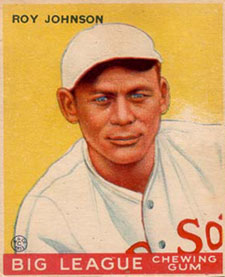 |
 |
|
|
|
|
|
|
|
|
|
|
|
|
|
|
|
|
|
|
|
|
 |
Your Father's Red Sox: Roy JohnsonOutfielder, 1932-35
Roy Johnson traversed a difficult path en route to Boston, where his bat and leadership helped the Red Sox escape an abysmal stretch of losing.
During an era when any minority was often made to feel as an inferior foreigner, the Oklahoma-born Johnson overcame the bigotry associated with his one-quarter Cherokee Indian background to excel in a sport that featured less than 30 known American Indian or part-Indian ballplayers in the pre-World War II era. Despite his ethnic background, Johnson shared a common path with most players of his era, who were discovered in the various industrial and minor leagues throughout the country. Johnson rose to his baseball prominence in the Pacific Coast League with the San Francisco Seals, and Detroit reportedly paid him a $50,000 bonus after he hit .375 in 1928. The left-handed hitting Johnson paid immediate dividends for the Tigers in 1929, leading the league in at-bats (640) and doubles (45) in a rookie season where he amassed 201 hits. Johnson was an outfielder blessed with a strong, but often inaccurate, arm. Although he twice led the league in assists, Johnson set the still-standing AL record for errors by an outfielder with 31 in his first Major League season. Over his 10-year career, he had 128 assists, but 156 errors. ďNot only was Roy a fine hitter, but he had a rifle arm. At times you didn't know where the ball was going but it was going to get there fast,Ē former Seals teammate Earl Averill told the Tacoma News Tribune upon Johnsonís death in 1973. It was a combination of erratic defense and a decline in offense that made Johnson expendable. After getting off to the slowest start of his career in 1932, hitting just .251 in 49 games, the Tigers on June 13 packaged Johnson with Dale Alexander in exchange for Earl Webb Alexander proved to be a wonderful short-term gain for Boston, winning the league batting crown with a .367 average in what turned out to be his final full season in the big leagues due to injuries. But it was Roy Johnsonís steady offensive production over the next four years that would eventually help the Red Sox part ways with an unprecedented stretch of losing. When Johnson arrived in Boston the Red Sox were amidst their worst season in franchise history, as the 1932 team finished 43-111 (and 64 games back of the Yankees). In 1933, the Red Sox improved to 63-86 when Johnson led the team in batting average, home runs and RBIís (and errors with 25). In 1934 Johnson had the best year of career, and his .320 average and team-high 119 RBIís helped the Red Sox (76-76) end 15 consecutive years of losing seasons. The 1935 team finally broke the .500 barrier, as Johnsonís team-leading .315 average and career-best .398 OBP paced a Red Sox team that finished 78-75. After helping the Red Sox franchise regain solid footing in the American League, Boston traded Johnson to Washington on December 17, 1935 for future Hall-of-Famer Heinie Manush. But Johnson never played for the Senators, who sent him to the Yankees one month later. In an ironic twist of fate that has played out too many times before and since, Johnson is among the crop of former Red Sox players who went on to win a championship wearing pinstripes, Johnsonís coming in his only full season with the Yankees in 1936. A more positive footnote to the Johnson chapter in Boston occurred in 1944 when his younger brother, Bob Johnson (nicknamed ďIndian BobĒ), joined the Red Sox for the final two seasons of his 13-year career. In 1944, Bob hit .324 for Boston, made his seventh All Star team, and became one of only 18 Red Sox in team history to hit for the cycle. But Bob mostly made his mark in Philadelphia with the Aís. Roy Johnson, on the other hand, was a .313 career hitter in Boston, where his best years took place, and he helped the Red Sox escape their worst years, no small feat for a team that had become accustomed to losing.
|
